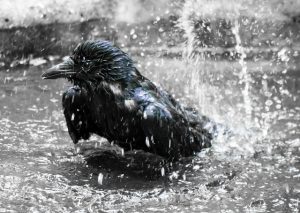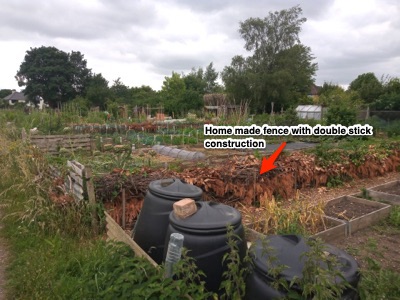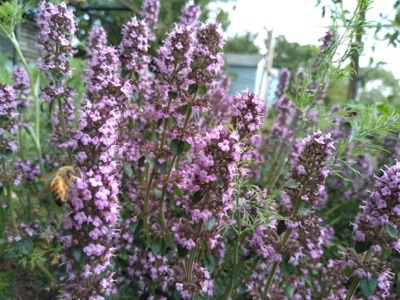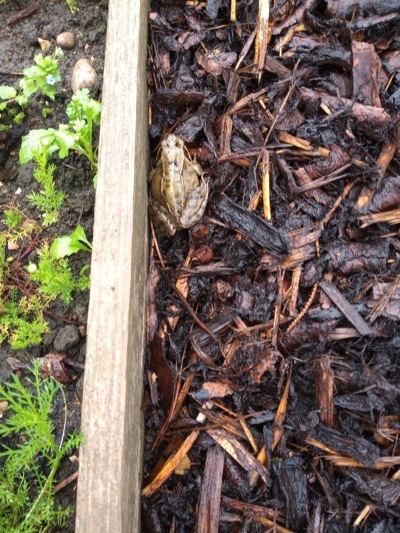Below are some suggestions for encouraging wildlife, please do refer to the many books available on organic gardening, as they include practices beneficial to wildlife and natural pest control for allotments.
January
- Birds need to bathe to keep their feathers in good condition, so provide a bird bath and enjoy the sight.

A raven taking a bath - Food is scarce at this time of year, put out appropriate food for the bird species local to your site at least until spring.
- Order your wild flower seeds..
-
Fix a box designed for bats on a tree, though they may prefer to roost under loose tiles or in the loft of surrounding houses.
February
-
Well designed and located nest boxes are used by tits, robins, sparrows, house martins and other birds. Make sure boxes are clean and in good condition.
-
Prune fruit trees & cut back hedges as late in winter as possible to avoid reducing food and shelter when wildlife needs it most.
-
Plant trees and shrubs.
-
Put out slug traps around new sowings and plantings – preferably a week or two before sowing or planting.
-
Dig up over-wintering brassicas as soon as you have finished harvesting as they can harbour pest and diseases.
March
- Catch rainwater in butts and to reduce evaporation caused by the sun’s heat, water plants in the evening.
- Divide established marginal, pond and wetland plants.
- Cut back shrubby herbs such as lavender, sage and thyme.
- Prune shrubs that flower on new shoots, eg. Buddleja Davidii
- Look out for the first show of bees and other insects, bird’s nests and spring flowers.

-
A good mulch and minimal cultivation (no-dig approach) is an ideal environment for ground beetles – the best slug predator.
April
- Climbing plants such as honeysuckle, ivy and clematis provide hiding places for moths and butterflies as well as nest sites for birds.
- A wildflower area is beautiful to look at and excellent for birds, butterflies, grasshoppers and other invertebrates.
- Remove invasive plants from your wildflower area.
- Cut and remove arisings from wildflower areas sown the previous autumn.
- Protect newly sown vegetables with barriers where necessary, eg. Put cabbage root fly mats on brassicas and fleece on early carrots.
- Plants with big bold, open flowers or small florets of the umbelliferous family are excellent for attracting the right kind of predators. These include cow parsley, phacelia, carrot (biennial) and poached egg plant.
- Sow hardy annuals like pot marigolds outside (attracts hoverflies and confuses pests).
- Top dress areas with an organic garden fertiliser.
- Inspect gooseberries and currants for sawfly and eggs from mid-spring.
- Install butterfly feeder for early butterflies. · Install ladybird feeder. · Plant water and wetland plants.
May
- Use peat-free compost to reduce further damage to the world’s dwindling peat bogs, ask your local garden centre to stock it.
- Grow nectar-rich flowers (native and non-native) for butterflies, moths, bees and other insects to drink from in summer.

Bee collecting nectar -
Watch for aphids but do not spray unless damage is severe as predators numbers will be on the increase.
June
- Net fruit bushes, raspberries and main crop strawberries; thin plums, pears and apples.
- Look out for cabbage caterpillars or eggs until early autumn.
- If you have one, cut down your nettle patch by half to provide new growth for egg laying butterflies.
July
- Keep bird baths regularly topped up.
- Cut spring wildflower meadows and remove arisings to compost heap.
- Cover flowering peas with mesh to protect against pea moth. · Most insecticides kill all insects, including bees and butterflies. Be patient and wait for nature to solve the ‘problem’!
- Experiment with companion planting and encourage natural predators for pests.
- Share techniques that work for you with fellow plot holders. The more organic gardening in your area, the easier it will be for nature to strike a balance with your help.

Frog in mulched area
August
- A wild corner with long grass and nettles will provide a feeding and over-wintering site for a variety of wildlife.
- Start sowing overwintering green manures.
- Cut hedges after birds are finished nesting.
- A pile of rocks and stones (or a dry stone wall) provides lots of sheltered spaces for hiding lizards and amphibians.
- Trim hedges once nesting birds have vacated.
- Position a lacewing chamber.
September
- Sow new wildflower meadows.
- Sow hardy annual attractants to overwinter and flower early.
- Take nets off fruit after harvesting to allow birds to get at overwintering pests.
- Feed and water birds to help them survive natural food shortages and hard weather.
- Allow berries and seeds to develop on your shrubs and plants. These will provide food for birds through the autumn and winter.
October
- Cut summer wildflowers and remove arisings to compost heap.
- Plant trees and hedge species.
- Hedges link other habitats together, provide shelter from the wind and sun, and food and nest sites for birds and mammals.
November
- Make a hedgehog hibernation box, or pile up logs, twigs and leaves to help these slug-eating mammals survive till spring.
- Put off tidying up until spring. This will help to provide beneficial insects with safe hibernation sites. Both ladybirds and lacewings like to over-winter in hollow stems. Ladybirds also like to hibernate amongst tussocky grass or dead leaves. Therefore, it helps to leave old plant material undisturbed during winter.
- Leave a patch of grass to grow long, or let a corner run a little wild!
December
- Feed wild birds from now until spring.
- Make cabbage root fly mats, bottle cloches, lacewing refuges, and bird and bat boxes.
- Cut down herbaceous plants after birds have taken seeds.
- Fork over soil where soil pests have been a problem.
Please see our:
- 15 top tips for encouraging wildlife on your plot
- Lansdowne Allotments Wildlife Watch
